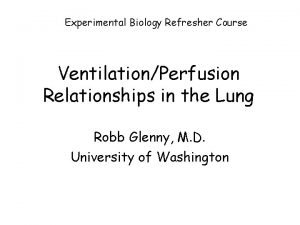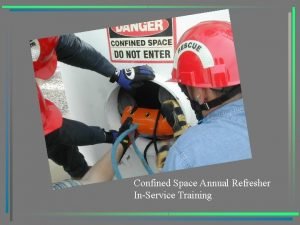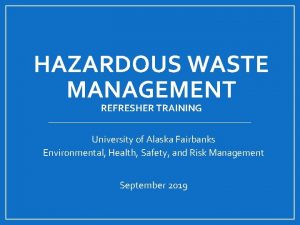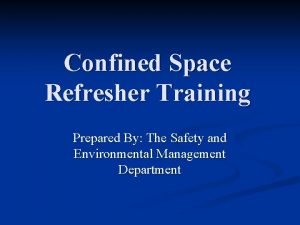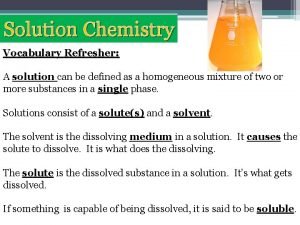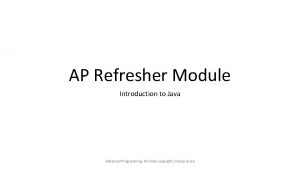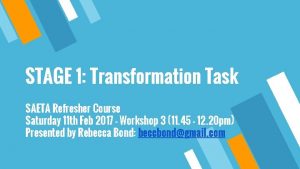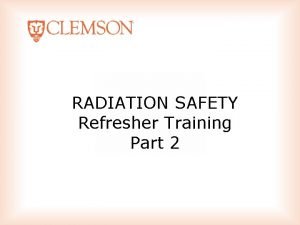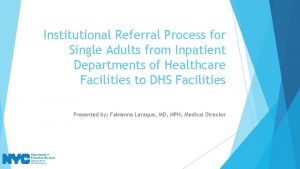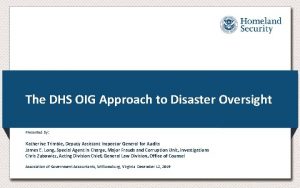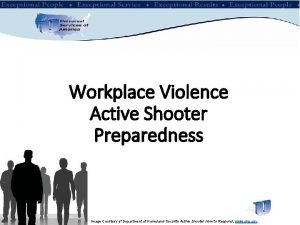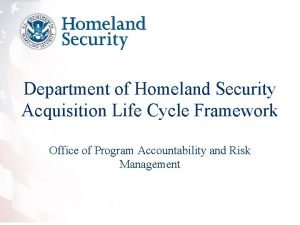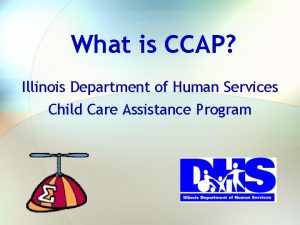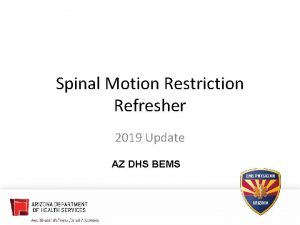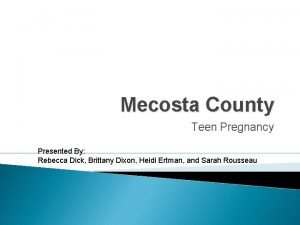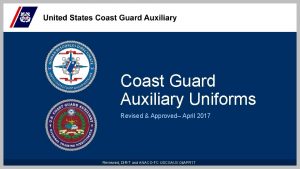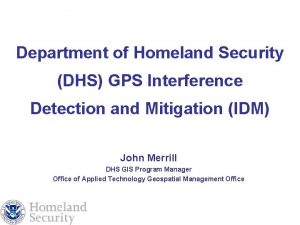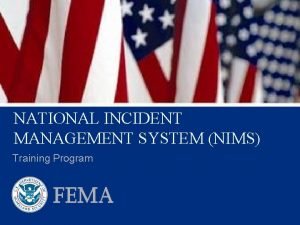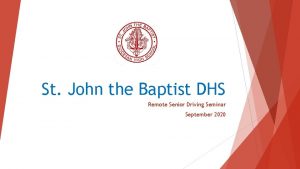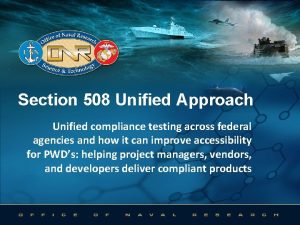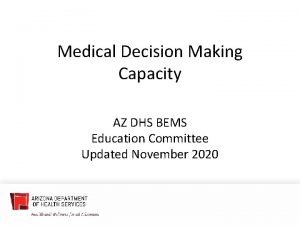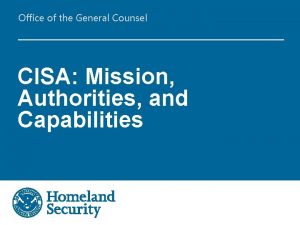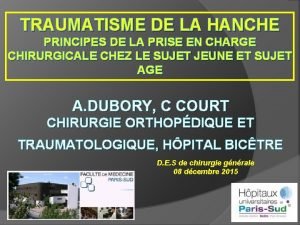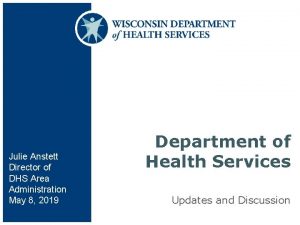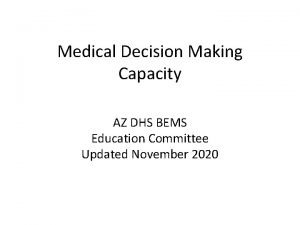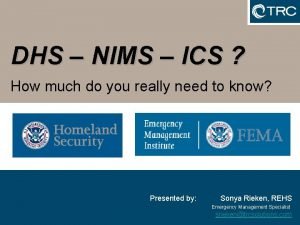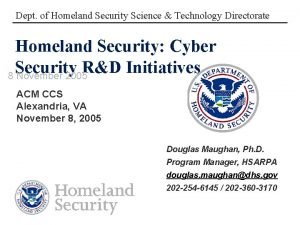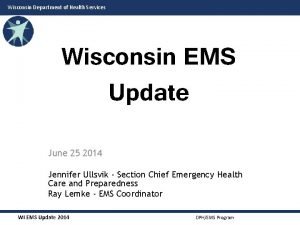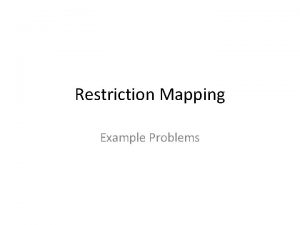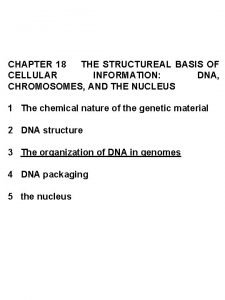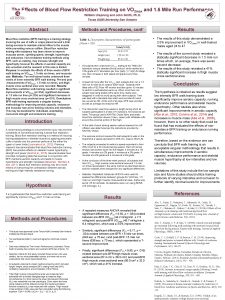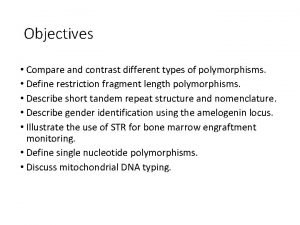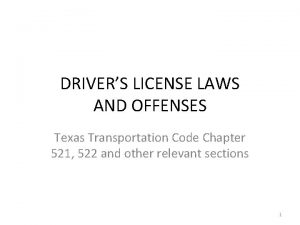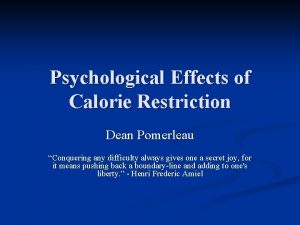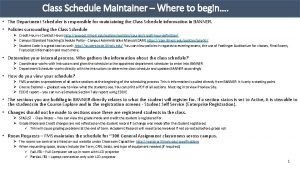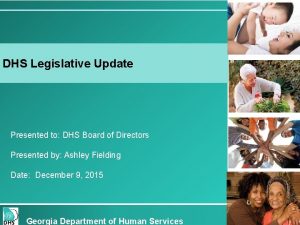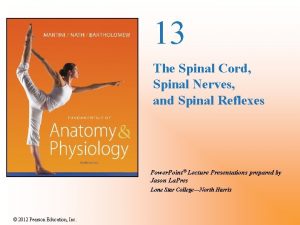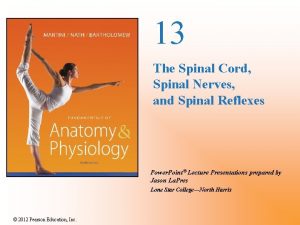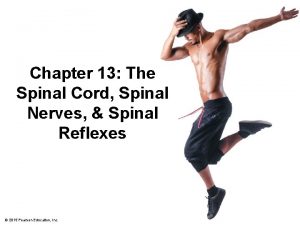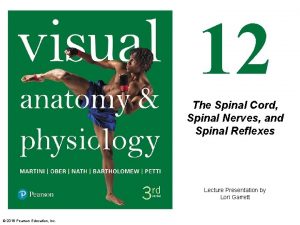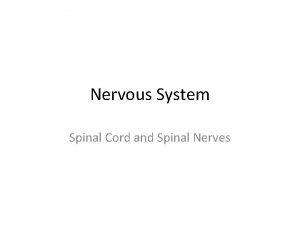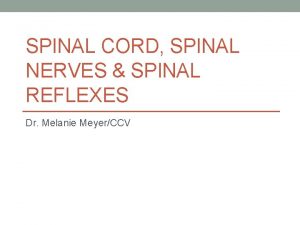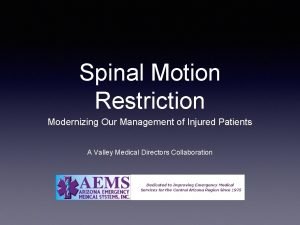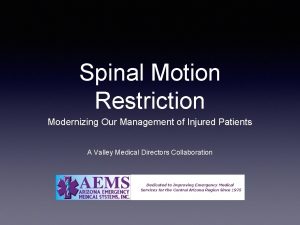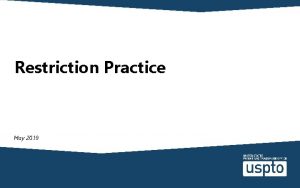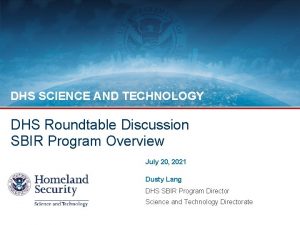Spinal Motion Restriction Refresher 2019 Update AZ DHS
































































- Slides: 64

Spinal Motion Restriction Refresher 2019 Update AZ DHS BEMS

Why are we doing a refresher? • Overall, we have had excellent success with the roll-out of SMR across Arizona • The incidence of spinal cord injury has NOT increased since the roll-out of SMR • However, there have been cases of missed cervical spine injuries – All of these cases have been due to protocol noncompliance***

How Does SI Hurt? • Cervical collars – Proven to increase ICP – Transfer force to ends – Obscure neck injuries – Produce axial distracting force – Make airway management more difficult

How Does SI Hurt? • Rigid long back boards – Cause iatrogenic pain – Cause 15 -20% reduction in respiratory capacity – Causes delays in transport – Possible risk of pressure ulcers

Backboards • Still reasonable for… IMPO RTAN T!!! – Blunt trauma with ALOC – Spine pain/tenderness and neuro complaint – Anatomic deformity of spine – High-energy mechanism or ALOC, distracting injury, inability to communicate

SMR Indications • Apply spinal motion restriction to any patient identified by the SMR algorithm to have a potential spine injury that might benefit from splinting and packaging • A complete patient assessment should be performed prior to application of SMR • This requires MORE critical thinking than simply putting everyone in a collar & strapping them to a backboard • Remember, EMS is not “clearing” the patient’s cervical spine

Who needs SMR Screening? • • • Fall Injury MVC Pedestrian Struck Bicyclist Struck ATV accident Altered & Found down Head injury Diving injury Contact sports injury Horseback riding injury • Motorcycle accident • •

Spinal Motion Restriction Includes: • Cervical collar with patient in supine position on gurney • Supine position with vacuum mattress • Supine position on scoop stretcher, secured with straps • Child car seat with supplemental padding • Supine position on long spine board, secured with straps and supplemental padding ***Level of SMR dependent on pt condition, comorbidities, & ability to tolerate position***

• The Big Change for SMR is Supine Positioning

SMR Adult Blunt Trauma

Adults: Low Risk Patients • • Minor rear-end collisions Ambulatory on scene at any time No neck pain on scene No midline cervical spine tenderness or anatomic abnormality • MUST BE GCS = 15, reliable, no distracting injuries, no intoxication, no neuro complaints or findings***

Adult Low Risk Patients Ages 15 -65 ***These patients do not need a collar or backboard***


** add slide for reminder decreasing movement verbage/increase pt safety. If refusal, please document.

Adult High Risk Patients Age > 65!!! Positive exam or complaint (deformity, midline pain, numbness, tingling or weakness)

Adult High Risk Patients Step 3 from the trauma triage criteria (ACS criteria) Adult fall > 20 feet (One story is equal 10 feet) Ejection from automobile Death in the same passenger compartment Vehicle intrusion > 12 inches, occupant site. > 18 inches, any site Motorcycle crash > 20 mph Auto vs. Pedestrian/Bicyclist (Thrown, run over, or with significant impact)

Adult High Risk Patients Diving injuries or axial loading Sudden acceleration/deceleration Bending forces to the neck and torso Violent impacts to the head, neck, torso or pelvis (excludes isolated penetrating trauma) Presence of numbness or parasthesias

Adult High Risk Patients ***You should STRONGLY CONSIDER SMR packaging these patients*** As in, “default to a collar/supine at a minimum, until patient condition obviously deteriorates because of it. ” If patient does not tolerate this, document on e. PCR.

Adult High Risk Patients • If a patient meets high risk mechanism criteria, strongly consider SMR – Cervical collar and supine position on gurney, scoop stretcher, vacuum mattress, or backboard • If patient is unable to tolerate a collar, supine position, or backboard this MUST be clearly documented in the e. PCR • If needed, hold manual c-spine instead of forcing a collar onto patient

Unreliable Patients • Uncooperative • Evidence of drug or alcohol intoxication and/or use – Do they have decision making capacity? ? ? • Painful or distracting injuries • Language barrier or inability to communicate – Dementia, developmental delay **All of these patients must get some form of SMR. If you cannot apply a cervical collar, you must document why. **

Backboards • Still reasonable for… IMPO RTAN T!!! – Blunt trauma with ALOC – Spine pain/tenderness and neuro complaint – Anatomic deformity of spine – High-energy mechanism or ALOC, distracting injury, inability to communicate

Isolated Penetrating Trauma • No role for SMR in Isolated Penetrating Trauma **Applies to both Adults and Pediatrics**

SMR Peds Blunt Trauma

Pediatric High Risk Patients Step 3 from the trauma triage criteria (ACS criteria) Pediatric fall > 10 feet or 2 -3 times the height of the child Speed > 55 MPH Ejection from automobile Death in the same passenger compartment Vehicle intrusion > 12 inches, occupant site. > 18 inches, any site Head on or roll over collision Motorcycle crash > 20 mph Auto vs. Pedestrian/Bicyclist (Thrown, run over, or with significant impact)

Pediatric High Risk Patients Diving injuries or Axial loading Sudden acceleration/deceleration Bending forces to the neck and torso Violent impacts to the head, neck, torso or pelvis (excludes isolated penetrating trauma) Presence of numbness, parasthesias, or weakness Altered LOC (GCS less than 15)

Pediatric Physical Assessment • Palpate the spine – pain or deformity? • Self-Limited movement of the neck = predictive of injury Use collar with log roll precautions • Wrist/Hand extension bilaterally (no longer grips) • Foot plantar flexion bilaterally (push foot down) • Foot dorsiflexion bilaterally (pull foot up) • Check sensation in all extremities – Evaluate for numbness/tingling/parasthesias

Backboards • Still reasonable for… IMPO RTAN T!!! – Blunt trauma with ALOC – Spine pain/tenderness and neuro complaint – Anatomic deformity of spine – High-energy mechanism or ALOC, distracting injury, inability to communicate

Case Studies

Case #1 • 0540: Fall Injury • 55 yo male, fell from standing at home, c/o lac to eyebrow, admit to 3 beers, found on ground • Clear speech, A/Ox 4, motor exam nl, no TTP, FROM, sensory grossly intact

Case #1 • En route to hospital now C/o tingling in both hands • How does this change your initial SMR decision? • What do you think happened while en route?

Case #2 • 1430: Fall Injury • 58 yo obese male found on bathroom floor – very small space • Denied falling, just too weak in legs • Complex extrication, A/Ox 4, motor intact, no TTP

Case #2 • Hx of cervical spinal stenosis • C/O severe burning and tingling in hands • “But they always tingle to some degree…” • Does it matter that tingling may be old? • Does it matter if he fell? Can you trust story?

Central Cord Syndrome

Case #3 • 1815: 962 • 91 yo male, front passenger, T-boned to PS, moderate damage, found sitting in PS • C/O severe R ribcage pain, crying, difficult to assess due to pain • Motor intact, sensory intact, spine intact, ? TTP

Case #3 • Patient screaming in pain once on backboard supine • HR 130, RR 30, obvious distress • Now what can you do?

Case #4 • 1448: Fall Injury • 87 yo female, slip on wet sidewalk, found on ground, c/o R hip pain • RLE rotated, shortened, TTP hip, A/Ox 4, motor/sensory intact, head normal, neck, back no TTP • Hip pain severe, tearful, yelling at times

Case #4 • Isolated hip fractures and spine injury • Do we need to SMR all hip fractures > 65? • Study showed: – 1394 patients with hip fracture, 23 (1. 7%) had cspine fracture as well – Of those > 65 (565 patients), standing or sitting mech only, only 2 (0. 4%) had c-spine fractures – Both had other criteria to apply collar: head injury, ALOC

Case #4 • Isolated hip fractures and spine injury • Do we need to SMR all hip fractures > 65? • Yes, SMR that hip fracture if you have sign or history of head injury, any ALOC, or other SMR indicators • But, pain from hip fracture alone might not mandate SMR

Case #5 • 62 y. o. female found by sister lying prone on ground with altered level of consciousness • Last seen 2 days prior • A & O x 2 (person & place) • Incontinent to urine • Left orbital swelling & bruising • Back = intact, no pain or step-offs • MS x 4 intact

Case #5 • Collar? • Backboard? • Patient transported without any collar or backboard • Found to have diffusely metastatic cancer with brain lesions and lesions throughout the bones • C 7 pathologic fracture with spinal cord compression • Underwent surgical repair of unstable fracture

Case #6 91 y. o. female sitting on the toilet Fell forward, striking head No loss of consciousness Frontal hematoma GCS 15 and A & O x 4 No midlines cervical, thoracic, or lumbar spine tenderness • No neurologic symptoms • • •

Case #6 • Collar? • Backboard? • Patient transported without cervical collar or SMR • Patient found to have Subdural hematoma and C 1 fracture • Underwent surgical repair

Case #7 • 29 y. o. male police officer enters fire station to use the restroom • Fire personnel heard noise, found officer on ground • Officer not sure what caused him to fall • Repetitive questioning (what is GCS score? ) • No midline cervical, thoracic, or lumbar spine tenderness • No neurologic symptoms


Case #7 • Collar? • Backboard? • Patient transported without collar or SMR • GCS incorrectly scored as “ 15” • Patient found to have vertebral fracture with vertebral artery dissection

Vertebral Artery & Spine

Car Seats?

Car Seats • Ok to use if: – car drivable – nearest car door undamaged – no injuries to any occupant – no airbag deployment – no visible damage

Car Seats

Case #8 • 1235: Sports Injury • 17 yo male, high school football game, rough tackle with hard head impact, brief LOC • C/o headache, nausea, amnestic to event, but now A/Ox 4; normal neuro exam, neck/back normal • Was ambulatory on scene • Trainer and private EMS applied full SMR: backboard/collar

Schools, Pools, Sports • Be a good neighbor • Reach out to city pools, school sports programs • Work with lifeguard, athletic trainer groups • Make sure vision, concepts, expectations are aligned • If already packaged, don’t change course unless something going wrong

Case #9 • 1755: Fall from horse • 38 yo female fall from horse, walked out 0. 5 miles to road • C/O neck/back soreness, +scalp abrasion diffuse back muscle TTP, neuro intact, GCS = 15, A/O x 4

Case #9 May not need any SMR Patient transported in position of comfort ED work up negative Sister wrote complaint to Fire Chief and Mayor (no collar or backboard! “malpractice!”) • Crew didn’t explain decision/protocol to patient or family • •

Case #9 • SMR is still considered new • Patients, family, other health care professionals might not understand • Make sure vision, concepts, expectations are aligned

Case #10 • 1010: MVC • 12 yo male, rear passenger, car struck from behind, mod damage • Hx of Down’s Syndrome • Was ambulatory on scene

Case #10 • Friendly on exam, follows commands, A/O to self, location, circumstance, day • GCS = 15 • Mild muscular neck TTP, neuro intact

Pediatric Predictors of Spine Injury • AMS, neuro deficits (same as adults) • Neck pain, not midline tenderness • Torticollis (stiffness), substantial torso injury, diving, high-risk MVC, and predisposing conditions • What are predisposing conditions?

Atlantoaxial Instability (AAI) • Occurs in approximately 15% of people with Down Syndrome • Typically asymptomatic • Can result in instability (laxity) of the cervical spine • More prone to spinal injuries with spinal manipulation (including SMR/collar use) • Manipulation of neck for airway management can result in spinal cord injury in patients with AAI

Atlantoaxial Instability Atlas Axis


C-1 subluxed on C-2 compresses spinal cord


Questions

THANK YOU Presenter Name | Title presentersemail@azdhs. gov | 602 -542 -1025 azhealth. gov @azdhs facebook. com/azdhs
 Figure 13-1 the spinal cord
Figure 13-1 the spinal cord Median nerve innervates
Median nerve innervates Inferior gluteal nerve
Inferior gluteal nerve Spinal nerves
Spinal nerves Deferred update and immediate update
Deferred update and immediate update Alveolar gas equation
Alveolar gas equation Refresher training example
Refresher training example Java advanced exercises
Java advanced exercises Sql refresher
Sql refresher Confined space refresher training
Confined space refresher training Refresher briefing
Refresher briefing Rcra hazardous waste refresher
Rcra hazardous waste refresher Confined space refresher training
Confined space refresher training Chemistry molarity
Chemistry molarity Ifr refresher
Ifr refresher Information security program refresher training
Information security program refresher training Biology refresher
Biology refresher Ipv refresher course
Ipv refresher course Java refresher course
Java refresher course Gdpr refresher training
Gdpr refresher training Saeta refresher course 2021
Saeta refresher course 2021 Radioactive refresher cocktail
Radioactive refresher cocktail Rt 130 refresher
Rt 130 refresher Dhs shelter referral form
Dhs shelter referral form Dhs oig
Dhs oig Dhs workplace violence
Dhs workplace violence Dhs science and technology directorate org chart
Dhs science and technology directorate org chart Acquisition lifecycle framework
Acquisition lifecycle framework Dhs
Dhs What is ccap
What is ccap Siakad2013 uny
Siakad2013 uny Az dhs
Az dhs Mecosta county dhs
Mecosta county dhs Dhs
Dhs Uscg bravos uniform
Uscg bravos uniform Pntip
Pntip Nims dhs
Nims dhs St john the baptist dhs
St john the baptist dhs Unified compliance framework
Unified compliance framework Capacity medicine
Capacity medicine Dhs selc guidebook
Dhs selc guidebook Dhs dress code
Dhs dress code Cisa crr
Cisa crr Triangle de ward femur
Triangle de ward femur Anna benton wi dhs
Anna benton wi dhs Dr ajoy chakraborty dhs
Dr ajoy chakraborty dhs Az dhs
Az dhs Az dhs ems
Az dhs ems Dhs nims
Dhs nims Dhs s&t org chart
Dhs s&t org chart Wisconsin ems e licensing
Wisconsin ems e licensing Example 2
Example 2 Restriction fragment analysis
Restriction fragment analysis Restriction enzyme mapping
Restriction enzyme mapping Asymmetrical and symmetrical iugr
Asymmetrical and symmetrical iugr Carte de restriction linéaire
Carte de restriction linéaire Restriction mapping
Restriction mapping Blood flow restriction protocol
Blood flow restriction protocol Restriction enzymes
Restriction enzymes Restriction enzyme
Restriction enzyme Restriction enzyme analysis of dna ap bio lab
Restriction enzyme analysis of dna ap bio lab Restriction fragment length polymorphism
Restriction fragment length polymorphism Texas transportation code 521.025
Texas transportation code 521.025 Cronies calorie restriction
Cronies calorie restriction Uiuc course explorer
Uiuc course explorer





